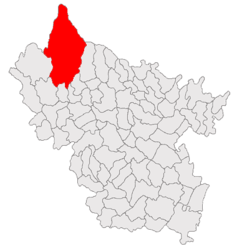Our website is made possible by displaying online advertisements to our visitors.
Please consider supporting us by disabling your ad blocker.
Gura Teghii
Gura Teghii | |
|---|---|
 Location in Buzău County | |
| Coordinates: 45°29′N 26°25′E / 45.483°N 26.417°E | |
| Country | Romania |
| County | Buzău |
| Subdivisions | Furtunești, Gura Teghii, Nemertea, Păltiniș, Secuiu, Vadu Oii, Varlaam |
| Government | |
| • Mayor (2020–2024) | Gheorghe Micleru[1] (PMP) |
Area | 466.19 km2 (180.00 sq mi) |
| Population (2021-12-01)[2] | 3,003 |
| • Density | 6.4/km2 (17/sq mi) |
| Time zone | EET/EEST (UTC+2/+3) |
| Postal code | 127280 |
| Vehicle reg. | BZ |
Gura Teghii is a commune in Buzău County, Muntenia, Romania, located in the north-westernmost part of the county in its mountain region, near the limit of Covasna and Vrancea counties, in the Curvature Carpathians. Gura Teghii made up of seven mountain villages (Furtunești, Gura Teghii, Nemertea, Păltiniș, Secuiu, Vadu Oii, Varlaam) on the valley of the river Bâsca Roziliei and of its tributaries, Bâsca Mică and Bâsca Mare.
Mentioned in documents starting with the 16th century, these settlements were founded by the yeomen from Sibiciu area, who had owned those lands before they were taken over by wealthy boyar landowners. The locals have kept their old Wallachian traditions with Transylvanian influences well into the modern era. At first, they bred cattle, then they became coopers and carpenters passing their trade from generation to generation, while mostly illiterate. The first schools in the commune appeared towards the end of the 19th century, when a major lumber mill was opened in nearby Nehoiu. Skilled workers from Gura Teghii were hired in the lumber mill. While some landowners attempted to start businesses in tourism, but during the Communist era, this activity went into decline, being revigorated nowadays only by a few bed and breakfasts.
- ^ "Results of the 2020 local elections". Central Electoral Bureau. Retrieved 15 June 2021.
- ^ "Populaţia rezidentă după grupa de vârstă, pe județe și municipii, orașe, comune, la 1 decembrie 2021" (XLS). National Institute of Statistics.
Previous Page Next Page



